Modern Warfare 3 vs. Battlefield 3
Digital Foundry on how the real battle lies ahead.
Some might say that the war was over before it truly began. The extraordinary sparring between Electronic Arts and Activision, encompassing developers and executives alike, may well have made for good copy for us journalist types, but where it matters - with the gamers - the results look rather one-sided. Preliminary sales data points to just one winner in the great Battlefield 3/Modern Warfare 3 kerfuffle: Activision has clearly emerged triumphant with what it is describing as the biggest launch in the history of the entire entertainment business.
Perhaps EA will be examining its week-one sales and thinking that Battlefield 3's performance should have been better, bearing in mind the gargantuan marketing spend put behind the product. From a UK perspective, BF3 sold less than half as many copies as FIFA 12 managed in the same time period, and is way behind the total amassed by Call of Duty: Black Ops' own week one sales. The extent of Modern Warfare 3's sales has yet to be fully ascertained, but the evidence seems to point to an even greater level of success than last year's game.
But to what extent was this even a valid contest in the first place? In his Modern Warfare 3 review, Eurogamer's Dan Whitehead astutely remarks that "comparisons to Battlefield 3 are expected, but played back-to-back, also fairly futile. Where multiplayer is concerned, the two are far more different than their surface similarities would suggest."
Perhaps the truth is that in creating this phony war, Electronic Arts has managed to utilise the Activision brand and marketing in selling a different style of first-person shooter - which may well have been the plan all along. According to sources, BF3 has managed to double week-one sales of last year's Medal of Honor and has sold more than all previous Battlefield games combined in the same time period. That's pretty good going, not to mention an excellent platform for future titles in the series.
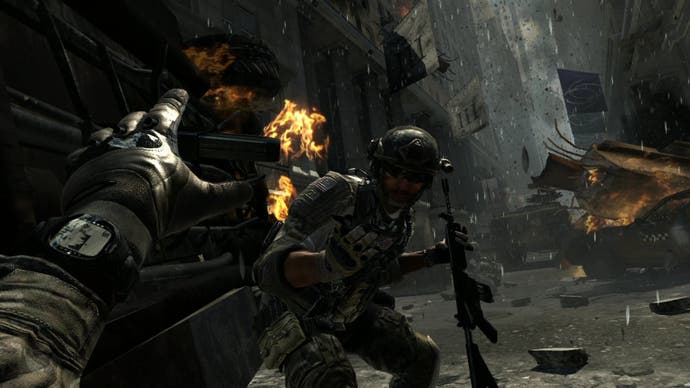

After all, it's worth remembering that Call of Duty didn't become a console phenomenon overnight - it took four years, four games and a new console generation before the series really ignited. Electronic Arts and DICE know this and have almost certainly planned for it. Our contention is that the war between these two heavyweights in the FPS genre isn't over at all - in fact the battle has only just begun - and gaming technology defines the conflict.
The gameplay offered up by 2007's epoch-making Call of Duty 4: Modern Warfare is intimately connected to the phenomenal technology at its core. The combination of state-of-the-art visuals married up to 60Hz gameplay produced a game that not only looked fantastic but also felt quite unlike anything else: it was arcade-like in its look and its controller response. The combination of this exceptional interface between player and game, along with the XP unlock mechanic, created a sensation. Infinity Ward and fellow COD studio Treyarch have spent the last four years building and iterating upon this base formula.
Let's take a look at how that low-latency interface benefits the player by comparing response between the Infinity Ward/Sledgehammer game and DICE's Battlefield 3 - both running on Xbox 360. Using a Ben Heck latency controller monitor board - the exact same piece of kit used by Infinity Ward itself to optimise pad response on previous COD titles - we can measure the responsiveness of the controls on each game. The pad inputs are connected to LEDs on the board, so measuring input lag is a simple matter of counting the number of frames between the LED illuminating and action kicking off on-screen.
With input lag measured at 50ms - or three frames - Modern Warfare 3 simply feels so much more crisp and responsive than any other first-person shooter we've played on the current-generation consoles. Somehow it even seems to be faster than other titles in the COD stable, as previously we've measured MW3's predecessors at anything between 66ms to 83ms latency. As swift and responsive as MW3 is, though, we should expect frame-rate drops to take a toll on that superlative level of response. However, where it matters most - in multiplayer - console frame-rates remain high, preserving that all-important feedback.
As the video demonstrates, Battlefield 3 on console - running at 30FPS - clearly has a deficit in response in comparison with Modern Warfare 3. Our latency measurement of 116ms might not sound too fantastic (it's over twice the response time of its competitor) but it is roughly ballpark within a frame or two with a whole host of other console shooters. For reference, 116ms is the same as Killzone 3 and 16ms faster than Epic's Bulletstorm.
However, Call of Duty's unique strength is also in a sense its greatest weakness. The notion of processing gameplay and rendering a whole new frame in less than 16.66ms means that key aspects of the tech are highly unlikely to improve radically during this console generation.
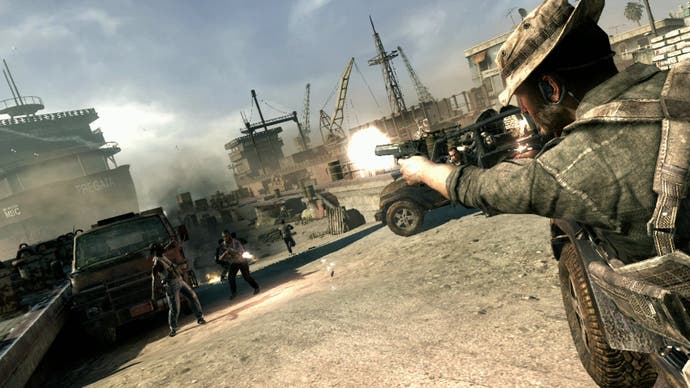

Changes made for Modern Warfare 3 are impressive though - if clearly incremental in nature. The gap in performance level between Xbox 360 and PlayStation 3 has been addressed to a certain extent, audio has significantly improved via a system of contextualised sound effects processing, similar in concept to (if not quite as effective as) the "HDR" audio instigated by DICE in its earlier Frostbite work. Lighting and particle effects work has seen some improvement, although the room for improvement here can only go so far owing to the tight rendering budget.
DICE's approach on console is remarkably different. While dropping down to 30 frames per second obviously impacts input lag, doubling the available rendering time opens up a whole new world of possibilities. The tile-based deferred rendering setup allows for lighting that is in a completely different league to what the IW engine is capable of on Modern Warfare 3, so hundreds of light sources can be rendered simultaneously - point lights, lens flare, emissive particles and muzzle flashes are all genuinely dynamic light-sources.
Similarly, while Call of Duty still allows for different materials to offer varying levels of resistance to bullet impacts, and renders decals on top of the environment detail to signify damage, DICE's destruction system actually allows for cover to be incrementally chipped away by incoming gunfire, and for entire structures to collapse, giving a more realistic, visceral experience - not to mention opening up new gameplay strategies. On a more macro level, DICE's engine also allows for more players and larger terrain, in turn opening up the ability to use a range of vehicles.
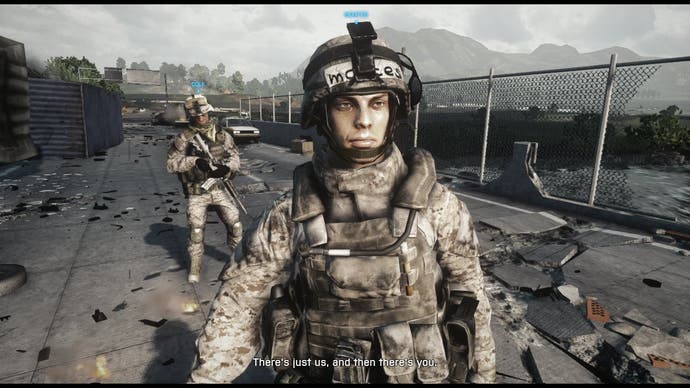

In a sense, Modern Warfare 3 plays like the ultimate iteration of a gameplay formula that first found its feet with Quake 3 Arena, while BF3 offers up a full-on Battlefield experience - visually the console versions may be cut-down, but every element of the core feature-set is there. Each game has its own strengths and weaknesses, essentially boiling down to a higher frame-rate and controller response against bigger maps, more players, and a higher level of fidelity in graphics and sound.
Clearly though, there are many points of similarity between the two single-player campaigns and it is here that the games are ripe for comparison. DICE chose to highlight the potential of the new Frostbite 2 technology here with a range of beautifully lit levels, showpiece destructive cut-scenes and a small clutch of the type of expansive terrains that are commonplace in the multiplayer game.
However, much of the campaign is based on the same type of linear, script-driven corridor-style gameplay that Call of Duty pioneered and of which its development studios are the masters, with BF3 simply not at the races. DICE also carbon-copied the COD concept of shifting across different locations by swapping between characters - though in this case the protagonists aren't really fleshed out at all and we don't care about their stories, making their eventual fates seem somewhat meaningless.
The net result is that up until the later stages, the design of BF3 feels very much like a COD game, but with the ultra-fast response swapped out for higher-detail characters, effects and lighting - and a whole lot less action. In what must surely be an almighty coincidence, there are also a number of shared locales and situations we've pulled out here from our previous Face-Off captures.
Put side by side like this, just in these few clips we can see a remarkable difference. Modern Warfare 3 won't just collapse a building on you, it'll precede it with a colossal explosion first and then send a burnt-out car flying past your face for good measure. It won't dispatch a bunch of police cars and a van to take you down, it'll helicopter in a bunch of troops and have them rappel down to earth to get to you. Perhaps the biggest difference between the Battlefield 3 and Modern Warfare 3 single-player campaigns is simply that Activision's adventure is just far more of an exciting place to be - their pacing and scripting work is on a whole different level. It's a game that is ram-packed with action and over-the-top effects, with no time whatsoever to catch your breath.
The video also serves to demonstrate just how much of an impact the 60 frames per second update makes to the overall presentation. In each of these clips we could reel off a substantial range of technological advantages offered up by the talented DICE tech team: the deferred shading, the filmic tonemapping, volumetric smoke, the advanced pixel shader work, the state-of-the-art animation... the list of new rendering tech is virtually endless. But Modern Warfare 3 rarely drops frames and there's never, ever any screen-tear. Combine that with the way the game feels in your hands and it's not difficult to understand why the Call of Duty series has evolved into the consummate console shooter.
So if the first fracas between the Battlefield and Call of Duty franchises has resulted in such an overwhelming sales victory for the Activision franchise, what evidence is there to suggest that the battle is far from over? What's to stop the same situation repeating for years to come?

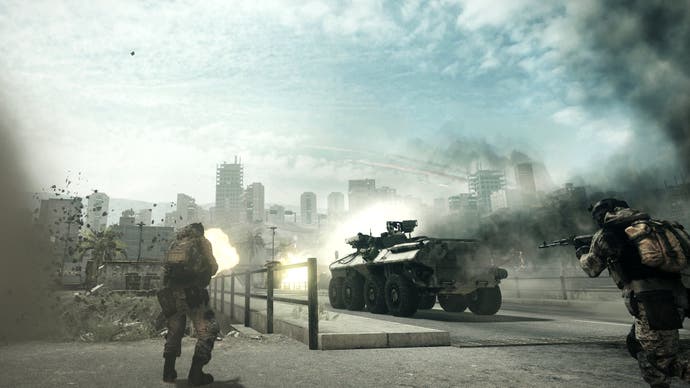
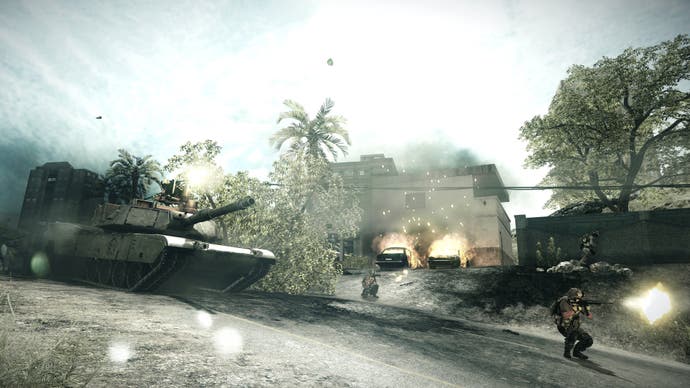
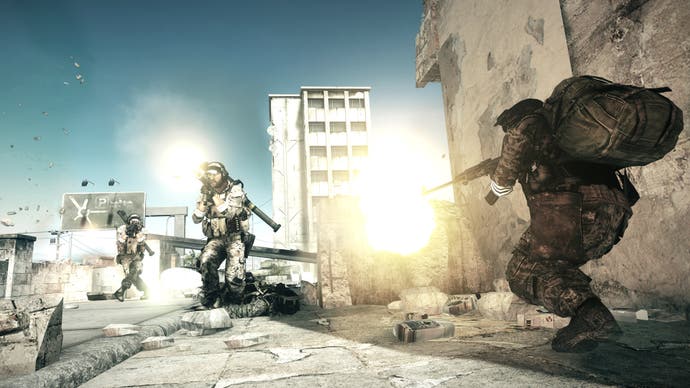
The answer is simple: run Battlefield 3 on any reasonably powerful PC on high settings, and something wonderful happens. Not only are the visuals drastically improved, but you can play at 60 frames per second too, with no tearing. Try out Modern Warfare 3 on PC after a few rounds of Battlefield 3 in all its DirectX 11 splendour and you'll realise that the underlying Infinity Ward technology is of an age that is swiftly drawing to a close. Pared-back lighting, effects work and low-resolution textures made for machines based on vintage 2005 technology just won't cut the mustard - especially when scaled up to 1080p and beyond.
Today's high-spec PC is tomorrow's games console, and the smart money says we're just two years away from the arrival of a DirectX 11-powered next-generation Xbox. EA and DICE's investment in Frostbite 2's more high-end technology isn't just for hardcore PC enthusiasts - it is laying the groundwork for the mainstream games of tomorrow. Even more exciting is the fact that Battlefield 3 is just its first game on the new engine, so by the time the new consoles arrive, Frostbite 2 will be even better than it is now. Certainly, despite the undoubted majesty of Battlefield 3 on PC, there are still improvements that we'd really like to see. For example, input lag, even on a high-end PC, wasn't hugely improved over what we saw on Xbox 360, unless we disabled v-sync and ran the game well in excess of 60FPS (with all the tearing that inevitably ensues).
If the BF3/MW3 conflict tells us anything it's that we're dealing with developers and publishers with two very different agendas: the COD studios clearly have their focus on the present day, while DICE is looking to the future. Frostbite 2 works well on current-gen consoles, but it's built to challenge for the next-gen. How will Activision's collection of talented COD-focused studios respond? Now that's the battle we're really looking forward to witnessing.









